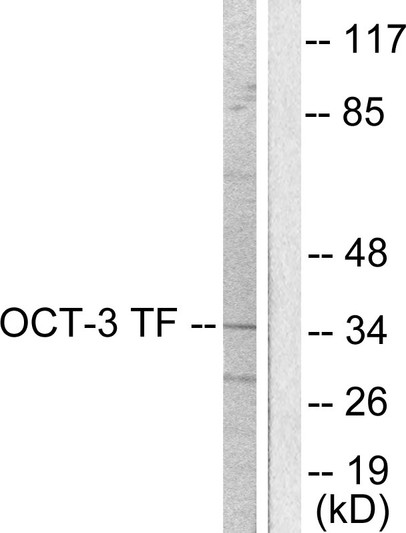| Tissue Specificity | Expressed in developing brain. Highest levels found in specific cell layers of the cortex, the olfactory bulb, the hippocampus and the cerebellum. Low levels of expression in adult tissues. |
| Post Translational Modifications | Sumoylation enhances the protein stability, DNA binding and transactivation activity. Sumoylation is required for enhanced YES1 expression. Ubiquitinated.undergoes 'Lys-63'-linked polyubiquitination by WWP2 leading to proteasomal degradation. ERK1/2-mediated phosphorylation at Ser-111 promotes nuclear exclusion and proteasomal degradation. Phosphorylation at Thr-235 and Ser-236 decrease DNA-binding and alters ability to activate transcription. |
| Function | Transcription factor that binds to the octamer motif (5'-ATTTGCAT-3'). Forms a trimeric complex with SOX2 or SOX15 on DNA and controls the expression of a number of genes involved in embryonic development such as YES1, FGF4, UTF1 and ZFP206. Critical for early embryogenesis and for embryonic stem cell pluripotency. |
| Protein Name | Pou Domain - Class 5 - Transcription Factor 1Octamer-Binding Protein 3Oct-3Octamer-Binding Protein 4Oct-4Octamer-Binding Transcription Factor 3Otf-3 |
| Database Links | Reactome: R-HSA-2892245Reactome: R-HSA-2892247Reactome: R-HSA-452723Reactome: R-HSA-9754189Reactome: R-HSA-9823739Reactome: R-HSA-9827857Reactome: R-HSA-9834899 |
| Cellular Localisation | CytoplasmNucleusExpressed In A Diffuse And Slightly Punctuate PatternColocalizes With Mapk8 And Mapk9 In The Nucleus |
| Alternative Antibody Names | Anti-Pou Domain - Class 5 - Transcription Factor 1 antibodyAnti-Octamer-Binding Protein 3 antibodyAnti-Oct-3 antibodyAnti-Octamer-Binding Protein 4 antibodyAnti-Oct-4 antibodyAnti-Octamer-Binding Transcription Factor 3 antibodyAnti-Otf-3 antibodyAnti-POU5F1 antibodyAnti-OCT3 antibodyAnti-OCT4 antibodyAnti-OTF3 antibody |
Information sourced from Uniprot.org












